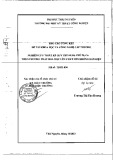
7,8-Diaminoperlargonic acid aminotransferase from
Mycobacterium tuberculosis, a potential therapeutic
target
Characterization and inhibition studies
Ste
´phane Mann and Olivier Ploux
Synthe
`se Structure et Fonction de Mole
´cules Bioactives, Universite
´Pierre et Marie Curie-Paris 6, UMR 7613, Paris, France
Tuberculosis remains one of the major infectious dis-
eases in the world, with a newly infected human every
second, one-third of the total population already infec-
ted, and 2 million deaths per year, according to the
WHO [1]. Furthermore, strains of Mycobacterium
tuberculosis, the pathogen, that are resistant to one or
several antibiotics used in therapy have been identified
and might thus compromise efforts to eradicate the
disease. New therapeutic targets and drugs, as well as
new vaccines and public health efforts are thus
urgently needed to decrease the incidence of tuberculo-
sis worldwide.
Keywords
7,8-diaminopelargonic acid
aminotransferase; amiclenomycin; biotin
biosynthesis; Mycobacterium tuberculosis;
S-adenosyl-L-methionine
Correspondence
O. Ploux, Synthe
`se Structure et Fonction de
Mole
´cules Bioactives, UMR7613 CNRS-
UPMC, Universite
´Pierre et Marie Curie,
boı
ˆte 182, 4, place Jussieu, F-75252 Paris
cedex 05, France
Fax: +33 1 44 27 71 50
Tel: +33 1 44 27 55 11
E-mail: olivier.ploux@upmc.fr
URL: http://www.upmc.fr/umr7613/
(Received 1 June 2006, revised 13 July
2006, accepted 23 August 2006)
doi:10.1111/j.1742-4658.2006.05479.x
Diaminopelargonic acid aminotransferase (DAPA AT), which is involved
in biotin biosynthesis, catalyzes the transamination of 8-amino-7-oxonona-
noic acid (KAPA) using S-adenosyl-l-methionine (AdoMet) as amino
donor. Mycobacterium tuberculosis DAPA AT, a potential therapeutic tar-
get, has been overproduced in Escherichia coli and purified to homogeneity
using a single efficient step on a nickel-affinity column. The enzyme shows
an electronic absorption spectrum typical of pyridoxal 5¢-phosphate-
dependent enzymes and behaves as a homotetramer in solution. The pH
profile of the activity at saturation shows a single ionization group with a
pK
a
of 8.0, which was attributed to the active-site lysine residue. The
enzyme shows a Ping Pong Bi Bi kinetic mechanism with strong substrate
inhibition with the following parameters: K
mAdoMet
¼0.78 ± 0.20 mm,
K
mKAPA
¼3.8 ± 1.0 lm,k
cat
¼1.0 ± 0.2 min
)1
,K
iKAPA
¼14 ± 2 lm.
Amiclenomycin and a new analogue, 4-(4c-aminocyclohexa-2,5-dien-1r-
yl)propanol (referred to as compound 1), were shown to be suicide sub-
strates of this enzyme, with the following inactivation parameters: K
i
¼
12±2lm,k
inact
¼0.35 ± 0.05 min
)1
, and K
i
¼20±2lm,k
inact
¼
0.56 ± 0.05 min
)1
, for amiclenomycin and compound 1, respectively. The
inactivation was irreversible, and the partition ratios were 1.0 and 1.1 for
amiclenomycin and compound 1, respectively, which make these inactiva-
tors particularly efficient. compound 1(100 lgÆmL
)1
) completely inhibited
the growth of an E. coli C268bioA mutant strain transformed with a
plasmid expressing the M. tuberculosis bioA gene, coding for DAPA AT.
Reversal of the antibiotic effect was observed on the addition of biotin or
DAPA. Thus, compound 1specifically targets DAPA AT in vivo.
Abbreviations
AdoMet, S-adenosyl-L-methionine; DAPA, 7,8-diaminopelargonic acid (7,8-diaminononanoic acid); DAPA AT, 7,8-diaminopelargonic acid
aminotranferase; KAPA, 8-amino-7-oxononanoic acid; PLP, pyridoxal 5¢-phosphate.
4778 FEBS Journal 273 (2006) 4778–4789 ª2006 The Authors Journal compilation ª2006 FEBS






























